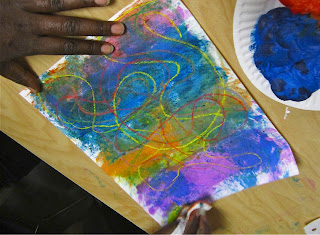"Shrink Art" for Valentine's Day
Shrink art plastic needs adult supervision, since you need to bake it in a standard kitchen oven for 3 minutes. Classroom teachers often take the whole set of finished projects home and bake them at their convenience over the weekend, returning the finished projects the following week. Once you get into practice you can bake 8 or 10 projects at a time, so this phase should not take you long. During the baking process, the projects transform to less than half their original size and take on a nice, thick density, thus the “shrink” part. Here you see baked and unbaked samples.
Children as young as 3 can have fun with this craft, since it’s an art form based on drawing. Young adults will enjoy it too, like my friends Emily and Maya who came by my house this weekend for a visit. This craft really does span all ages and ability levels, and it’s very motivating for both children and adults to watch the process of transformation.
Shrink-It Sheets (SHRINKIE) comes in a set of 24 opaque sheets for $14.59 with a clear, easy to follow instruction sheet. I prefer the opaque style sheets (they come in “clear” as well - CSHRINK) because colored pencils show best on the opaque version.
Now the fun part begins. Here’s what you’ll do.
Here I’m putting a Valentines design into my toaster oven where I’ll leave it for 3 minutes until it shrinks. I much prefer using a standard sized oven and baking 8 or 10 projects on a cookie sheet all at once, but a toaster oven will work in a pinch.
Lastly, here’s a page of “practically professional” shrink art designs to inspire you, created by my daughter Lillie who began with shrink art at about age four and continued until she was eight. When Lillie was a little girl, she absolutely loved to draw and she drew all the time, it was her passion. I’m sure you know children like that too. Shrink Art is the perfect craft for the child who loves to draw.
If you really get carried away with this craft like we did, you’ll find other applications like mounting them in these small wooden frames with a poem or some dictations. This makes them even fancier and adds about a dollar per project. These wooden frames are painted with Colorations® Liquid Watercolor so the wood grain shows through.
I hope you’ll add Shrink Art to your repertoire of arts and crafts ideas for both classroom use and for play dates at home. It certainly added a lot of pleasure and creativity to my home as our children were growing up. Oh, and one last thing: Shrink Art “charms” stand the test of time because they don’t break or wear out so your children’s creativity will essentially last forever. Now that’s something to write home about.
Materials You Will Need:
Shrink-It Sheets (SHRINKIE)
Sharpie® Ultra Fine Point Black Markers (SHARPULT)
Colorations® Regular Colored Pencils (COLORP)
One Hole Punch (OHP)
Wooden Standing Frames (WDFRM)
Colorations® Liquid Watercolor (13LW)
Labels: activity, arts and crafts, Discount School Supply, Shrink Art




















